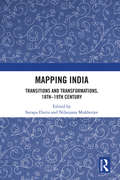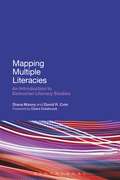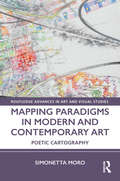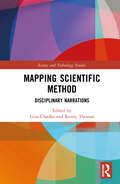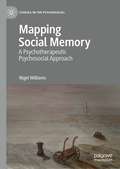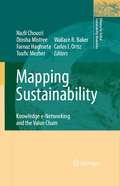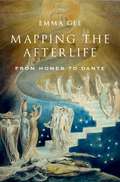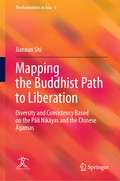- Table View
- List View
A Map of Selves: Beyond Philosophy of Mind (Routledge Studies in Metaphysics)
by N.M.L. NathanA Map of Selves defines a concept of selfhood, radically different from the Cartesian, neo-Humean, materialist and animalist concepts which now dominate analytical philosophy of mind. A self, as this book defines it, is an enduring substance with a quality which is its constant possession, which it does not share with any other substance, and which is often remembered by it as its own. The author maintains that we are selves as so defined. He criticises the panpsychist theory that material objects are composed of selves analogous to ours, and argues, further, for the existence of at least one transcendent self, whose activity explains both our own existence and the existence of the natural world. He ends by considering whether things would be worse for us if selves as the book defines them did not exist, and we were, as some philosophers suppose we are, just brains, or sequences of mental events, or hylemorphic structures, or subjects which last no longer than the specious present. Nathan’s carefully argued and original book will be of interest to researchers in metaphysics and philosophical psychology, and to their students.
Map Reading: The Nobel Lecture and Other Writings
by Abdulrazak Gurnah'One of the world's most prominent postcolonial writers … He has consistently and with great compassion penetrated the effects of colonialism and its effects on the lives of uprooted and migrating individuals' Anders Olsson, chairman of the Nobel CommitteeDelivered in London on 7 December 2021, 'Writing' is the lecture of the Nobel Laureate in Literature, Abdulrazak Gurnah. Collected here with three further essays, it explores his coming-of-age, his early experiences in 1960s Britain, the narratives of oceans, his lifelong love affair with reading, and the power of writing to subvert the stories that have been handed to us. Generous, funny and wise, this collection is the perfect introduction to the storyteller described as 'one of Africa's most important living writers'; whose work, now spanning four decades, continues to spin wonder and magic while offering penetrating insight into exile, migration and homecoming. 'In book after book, he guides us through seismic historic moments and devastating societal ruptures while gently outlining what it is that keeps those families, friendships and loving spaces intact' Maaza Mengiste'A wondrous writer' Philippe Sands
Map Reading: The Nobel Lecture and Other Writings
by Abdulrazak Gurnah'One of the world's most prominent postcolonial writers … He has consistently and with great compassion penetrated the effects of colonialism and its effects on the lives of uprooted and migrating individuals' Anders Olsson, chairman of the Nobel CommitteeDelivered in London on 7 December 2021, 'Writing' is the lecture of the Nobel Laureate in Literature, Abdulrazak Gurnah. Collected here with three further essays, it explores his coming-of-age, his early experiences in 1960s Britain, the narratives of oceans, his lifelong love affair with reading, and the power of writing to subvert the stories that have been handed to us. Generous, funny and wise, this collection is the perfect introduction to the storyteller described as 'one of Africa's most important living writers'; whose work, now spanning four decades, continues to spin wonder and magic while offering penetrating insight into exile, migration and homecoming. 'In book after book, he guides us through seismic historic moments and devastating societal ruptures while gently outlining what it is that keeps those families, friendships and loving spaces intact' Maaza Mengiste'A wondrous writer' Philippe Sands
Mapmatics: How We Navigate the World Through Numbers
by Paulina Rowinska'An expansive journey through time and place' - The Observer'An adventure' - Edward Brooke-Hitching, author of The Phantom AtlasHow does a delivery driver distribute hundreds of packages in a single working day?Why does remote Alaska have such a large airport?Where should we look for elusive serial killers?The answers lie in the crucial connection between maps and maths.In Mapmatics, Dr Paulina Rowinska embarks on a fascinating journey to discover the mathematical foundations of cartography and cartographical influences on mathematics.From a sixteenth-century map that remains an indispensable navigation tool despite emphasizing the North–South divide to public transport maps that both guide and mislead passengers, she reveals how maps and maths shape not only our sense of space and time but also our worldview.Through entertaining stories, surprising real-world examples and a cast of unforgettable characters, Mapmatics helps us to appreciate the mathematical methods and ideas behind maps. And, by illuminating how our world works, leaves us better equipped to understand and look after it.
Mapping and Measuring Deliberation: Towards a New Deliberative Quality
by André Bächtiger John ParkinsonDeliberative democracy has challenged two widely-accepted nostrums about democratic politics: that people lack the capacities for effective self-government; and that democratic procedures are arbitrary and do not reflect popular will; indeed, that the idea of popular will is itself illusory. On the contrary, deliberative democrats have shown that people are capable of being sophisticated, creative problem solvers, given the right opportunities in the right kinds of democratic institutions. But deliberative empirical research has its own problems. In this book two leading deliberative scholars review decades of that research and reveal three important issues. First, the concept 'deliberation' has been inflated so much as to lose empirical bite; second, deliberation has been equated with entire processes of which it is just one feature; and third, such processes are confused with democracy in a deliberative mode more generally. In other words, studies frequently apply micro-level tools and concepts to make macro- and meso-level judgements, and vice versa. Instead, Bächtiger and Parkinson argue that deliberation must be understood as contingent, performative, and distributed. They argue that deliberation needs to be disentangled from other communicative modes; that appropriate tools need to be deployed at the right level of analysis; and that scholars need to be clear about whether they are making additive judgements or summative ones. They then apply that understanding to set out a new agenda and new empirical tools for deliberative empirical scholarship at the micro, meso, and macro levels.
Mapping and Measuring Deliberation: Towards a New Deliberative Quality
by John Parkinson André BächtigerDeliberative democracy has challenged two widely-accepted nostrums about democratic politics: that people lack the capacities for effective self-government; and that democratic procedures are arbitrary and do not reflect popular will; indeed, that the idea of popular will is itself illusory. On the contrary, deliberative democrats have shown that people are capable of being sophisticated, creative problem solvers, given the right opportunities in the right kinds of democratic institutions. But deliberative empirical research has its own problems. In this book two leading deliberative scholars review decades of that research and reveal three important issues. First, the concept 'deliberation' has been inflated so much as to lose empirical bite; second, deliberation has been equated with entire processes of which it is just one feature; and third, such processes are confused with democracy in a deliberative mode more generally. In other words, studies frequently apply micro-level tools and concepts to make macro- and meso-level judgements, and vice versa. Instead, Bächtiger and Parkinson argue that deliberation must be understood as contingent, performative, and distributed. They argue that deliberation needs to be disentangled from other communicative modes; that appropriate tools need to be deployed at the right level of analysis; and that scholars need to be clear about whether they are making additive judgements or summative ones. They then apply that understanding to set out a new agenda and new empirical tools for deliberative empirical scholarship at the micro, meso, and macro levels.
Mapping Equity and Quality in Mathematics Education
by Bill Atweh, Mellony Graven, Walter Secada and Paola ValeroConcerns about quality mathematics education are often posed in terms of the types of mathematics that are worthwhile and valuable for both the student and society in general, and about how to best support students so that they can develop this mathematics. Concerns about equity are about who is excluded from the opportunity to develop quality mathematics within our current practices and systems, and about how to remove social barriers that systematically disadvantage those students. This collection of chapters summarises our learning about the achievement of both equity and quality agendas in mathematics education and to move forward the debate on their importance for the field.
Mapping European Economic Integration (Palgrave Studies in European Union Politics)
by Amy Verdun and Alfred ToviasBy examining the various policy subfields of European economic integration such as agriculture, trade, banking, economic governance and sustainability this book offers a comprehensive and wide-ranging analysis of developments that have taken place in the past five years aimed at exploring the path of economic integration in Europe.
Mapping Extreme Right Ideology: An Empirical Geography of the European Extreme Right
by M. Bruter S. HarrisonAn explanation of variations in the discourses and electoral success of 25 extreme right parties across 17 European political systems. The book shows how the European extreme right is mapped by the positions of parties and voters on two ideological dimensions, and how the match between these determines electoral success.
Mapping India: Transitions and Transformations, 18th–19th Century
by Sutapa Dutta Nilanjana MukherjeeThis book presents an alternate history of colonial India in the 18th and the 19th centuries. It traces the transitions and transformations during this period through art, literature, music, theatre, satire, textiles, regime changes, personal histories and migration. The essays in the volume examine historical events and movements which questioned the traditional parameters of identity and forged a new direction for the people and the nation. Viewing the age through diverse disciplinary angles, the book also reflects on the various reimaginings of India at the time. This volume will be of interest to academics and researchers of modern Indian history, cultural studies and literature. It will also appeal to scholars interested in the anthropological, sociological and psychological contexts of imperialism.
Mapping India: Transitions and Transformations, 18th–19th Century
by Sutapa Dutta Nilanjana MukherjeeThis book presents an alternate history of colonial India in the 18th and the 19th centuries. It traces the transitions and transformations during this period through art, literature, music, theatre, satire, textiles, regime changes, personal histories and migration. The essays in the volume examine historical events and movements which questioned the traditional parameters of identity and forged a new direction for the people and the nation. Viewing the age through diverse disciplinary angles, the book also reflects on the various reimaginings of India at the time. This volume will be of interest to academics and researchers of modern Indian history, cultural studies and literature. It will also appeal to scholars interested in the anthropological, sociological and psychological contexts of imperialism.
Mapping Mass Mobilization: Understanding Revolutionary Moments in Argentina and Ukraine
by O. OnuchThrough a paired comparison of two moments of mass mobilization, in Ukraine and Argentina, focusing on the role of different actors involved, this text maps out a multi-layered sequence of events leading up to mass mobilization.
Mapping Migration, Identity, and Space
by Timothy H. Parsons Tabea LinhardThis interdisciplinary collection of essays focuses on the ways in which movements of people across natural, political, and cultural boundaries shape identities that are inexorably linked to the geographical space that individuals on the move cross, inhabit, and leave behind. As conflicts over identities and space continue to erupt on a regular basis, this book reads the relationship between migration, identity, and space from a fresh and innovative perspective.
Mapping Multiple Literacies: An Introduction to Deleuzian Literacy Studies
by Diana Masny David R. ColeMappingMultiple Literaciesbrings together the latest theory and research in the fields of literacy studyand European philosophy, Multiple Literacies Theory (MLT) and the philosophicalwork of Gilles Deleuze. It frames the process of becoming literate as a fluidprocess involving multiple modes of presentation, and explains these processesin terms of making maps of our social lives and ways of doing things together.For Deleuze, language acquisition is a social activityof which we are a part, but only one partamongst many others..Masny and Cole draw on Deleuze's thinking to expand the repertoires of literacyresearch and understanding. They outline how we can understand literacy as asocial activity and map the ways in which becoming literate may take hold andtransform communities. The chapters in this book weave together theory, dataand practice to open up a creative new area of literacy studies and to provokevigorous debate about the sociology of literacy.
Mapping Multiple Literacies: An Introduction to Deleuzian Literacy Studies
by Diana Masny David R. ColeMappingMultiple Literaciesbrings together the latest theory and research in the fields of literacy studyand European philosophy, Multiple Literacies Theory (MLT) and the philosophicalwork of Gilles Deleuze. It frames the process of becoming literate as a fluidprocess involving multiple modes of presentation, and explains these processesin terms of making maps of our social lives and ways of doing things together.For Deleuze, language acquisition is a social activityof which we are a part, but only one partamongst many others..Masny and Cole draw on Deleuze's thinking to expand the repertoires of literacyresearch and understanding. They outline how we can understand literacy as asocial activity and map the ways in which becoming literate may take hold andtransform communities. The chapters in this book weave together theory, dataand practice to open up a creative new area of literacy studies and to provokevigorous debate about the sociology of literacy.
Mapping Musical Signification (Numanities - Arts and Humanities in Progress #15)
by Joan GrimaltThis book is a unique attempt to systematize the latest research on all that music connotes. Musicological reflections on musically expressive content have been pursued for some decades now, in spite of the formalist prejudices that can still hindermusicians and music lovers. The author organizes this body of research so that both professionals and everyday listeners can benefit from it – in plain English, but without giving up the level of depth required by the subject matter. Two criteria have guided his choice among the many ways to speak about musical meaning: its relevance to performance, and its suitability to the teaching context.The legacy of the so-called art music, without an interpretive approach that links ancient traditions to our present, runs the risk of missing the link to the new generations of musicians and listeners. Complementing the theoretical, systematic content, each chapter includes a wealth of examples, including the so-called popular music.
Mapping Paradigms in Modern and Contemporary Art: Poetic Cartography (Routledge Advances in Art and Visual Studies)
by Simonetta MoroMapping Paradigms in Modern and Contemporary Art defines a new cartographic aesthetic, or what Simonetta Moro calls carto-aesthetics, as a key to interpreting specific phenomena in modern and contemporary art, through the concept of poetic cartography. The problem of mapping, although indebted to the "spatial turn" of poststructuralist philosophy, is reconstructed as hermeneutics, while exposing the nexus between topology, space-time, and memory. The book posits that the emergence of "mapping" as a ubiquitous theme in contemporary art can be attributed to the power of the cartographic model to constitute multiple worldviews that can be seen as paradigmatic of the post-modern and contemporary condition. This book will be of particular interest to scholars in art history, art theory, aesthetics, and cartography.
Mapping Paradigms in Modern and Contemporary Art: Poetic Cartography (Routledge Advances in Art and Visual Studies)
by Simonetta MoroMapping Paradigms in Modern and Contemporary Art defines a new cartographic aesthetic, or what Simonetta Moro calls carto-aesthetics, as a key to interpreting specific phenomena in modern and contemporary art, through the concept of poetic cartography. The problem of mapping, although indebted to the "spatial turn" of poststructuralist philosophy, is reconstructed as hermeneutics, while exposing the nexus between topology, space-time, and memory. The book posits that the emergence of "mapping" as a ubiquitous theme in contemporary art can be attributed to the power of the cartographic model to constitute multiple worldviews that can be seen as paradigmatic of the post-modern and contemporary condition. This book will be of particular interest to scholars in art history, art theory, aesthetics, and cartography.
Mapping Scientific Method: Disciplinary Narrations (Science and Technology Studies)
by Gita Chadha Renny ThomasThis volume explores how the scientific method enters and determines the dominant methodologies of various modern academic disciplines. It highlights the ways in which practitioners from different disciplinary backgrounds –– the humanities, the natural sciences, and the social sciences –– engage with the scientific method in their own disciplines. The book maps the discourse (within each of the disciplines) that critiques the scientific method, from different social locations, in order to argue for more complex and nuanced approaches in methodology. It also investigates the connections between the method and the structures of power and domination which exist within these disciplines. In the process, it offers a new way of thinking about the philosophy of the scientific method. Part of the Science and Technology Studies series, this volume is the first of its kind in the South Asian context to debate scientific methods and address questions by scholars based in the global south. It will be useful to students and practitioners of science, humanities, social sciences, philosophy of science, and philosophy of social science. Research scholars from these disciplines, especially those engaging in interdisciplinary research, will also benefit from this volume.
Mapping Scientific Method: Disciplinary Narrations (Science and Technology Studies)
by Gita Chadha and Renny ThomasThis volume explores how the scientific method enters and determines the dominant methodologies of various modern academic disciplines. It highlights the ways in which practitioners from different disciplinary backgrounds –– the humanities, the natural sciences, and the social sciences –– engage with the scientific method in their own disciplines. The book maps the discourse (within each of the disciplines) that critiques the scientific method, from different social locations, in order to argue for more complex and nuanced approaches in methodology. It also investigates the connections between the method and the structures of power and domination which exist within these disciplines. In the process, it offers a new way of thinking about the philosophy of the scientific method. Part of the Science and Technology Studies series, this volume is the first of its kind in the South Asian context to debate scientific methods and address questions by scholars based in the global south. It will be useful to students and practitioners of science, humanities, social sciences, philosophy of science, and philosophy of social science. Research scholars from these disciplines, especially those engaging in interdisciplinary research, will also benefit from this volume.
Mapping Social Memory: A Psychotherapeutic Psychosocial Approach (Studies in the Psychosocial)
by Nigel WilliamsThis book is grounded in psychosocial research that explores the complex intergenerational transmission of memories within families and the transgenerational social issues that form a part of those memories. The author demonstrates that the organising framework of moving back and forth between inter- and transgenerational processes is key to mapping those relationships leading to the ideas of generational companionship, a multigenerational self and intergenerational mentalisation. Drawing on sociological and psychoanalytic approaches, it provides a framework for thinking about continuity and discontinuity in the lives of individuals and in the longer sweep of the generations. The role and potential for a psychosocial approach in deep-level problem solving is addressed through chapters on psychotherapy and on psychosocial interventions. Social imagination in personal and social healing is a core theme, as is the study of the relationship between creative and destructive forces that play out in human life. The book will be an invaluable resource for students and scholars of psychosocial research and psychotherapy as well as in memory studies, history, genealogy and social theory.
Mapping Sustainability: Knowledge e-Networking and the Value Chain (Alliance for Global Sustainability Bookseries #11)
by Nazli Choucri Wallace R. Baker Farnaz Haghseta Toufic Mezher Dinsha Mistree Carlos I. OrtizThis book focuses on three interdependent challenges related to managing transitions toward sustainable development. These are: mapping sustainability for global knowledge e-networking, extending the value chain of knowledge and e-networking, and engaging in explorations of new methods and venues for further developing knowledge and e-networking. While each of these challenges constitutes fundamentally different types of endeavors, they are highly interconnected. Jointly, they contribute to our expansion of knowledge and its applications in support of transitions toward sustainable development.
Mapping the Afterlife: From Homer to Dante
by Emma GeeThere are very few accounts of the afterlife across the period from Homer to Dante. Most traditional studies approach the classical afterlife from the point of view of its "evolution" towards the Christian afterlife. This book tries to do something different: to explore afterlife narratives in spatial terms and to situate this tradition within the ambit of a fundamental need in human psychology for the synthesis of soul (or "self") and universe. Drawing on the works of Homer, Plato, Cicero, Virgil, and Dante, among others, as well as on modern works on psychology, cartography, and music theory, Mapping the Afterlife argues that the topography of the afterlife in the Greek and Roman tradition, and in Dante, reflects the state of "scientific" knowledge at the time of the various contexts in which we find it. The book posits that there is a dominant spatial idiom in afterlife landscapes, a "journey-vision paradigm"--the horizontal journey of the soul across the afterlife landscape, and a synoptic vision of the universe. Many scholars have argued that the vision of the universe is out of place in the underworld landscape. However, looking across the entire tradition, we find that afterlife landscapes, almost without exception, contain these two kinds of space in one form or another. This double vision of space brings the underworld, as the landscape of the soul, into contact with the "scientific" universe; and brings humanity into line with the cosmos.
Mapping the Afterlife: From Homer to Dante
by Emma GeeThere are very few accounts of the afterlife across the period from Homer to Dante. Most traditional studies approach the classical afterlife from the point of view of its "evolution" towards the Christian afterlife. This book tries to do something different: to explore afterlife narratives in spatial terms and to situate this tradition within the ambit of a fundamental need in human psychology for the synthesis of soul (or "self") and universe. Drawing on the works of Homer, Plato, Cicero, Virgil, and Dante, among others, as well as on modern works on psychology, cartography, and music theory, Mapping the Afterlife argues that the topography of the afterlife in the Greek and Roman tradition, and in Dante, reflects the state of "scientific" knowledge at the time of the various contexts in which we find it. The book posits that there is a dominant spatial idiom in afterlife landscapes, a "journey-vision paradigm"--the horizontal journey of the soul across the afterlife landscape, and a synoptic vision of the universe. Many scholars have argued that the vision of the universe is out of place in the underworld landscape. However, looking across the entire tradition, we find that afterlife landscapes, almost without exception, contain these two kinds of space in one form or another. This double vision of space brings the underworld, as the landscape of the soul, into contact with the "scientific" universe; and brings humanity into line with the cosmos.
Mapping the Buddhist Path to Liberation: Diversity and Consistency Based on the Pāli Nikāyas and the Chinese Āgamas (The Humanities in Asia #9)
by Jianxun ShiDue to the diversity in Buddhism, its essence remains a puzzle. This book investigates the Buddhist path to liberation from a practical and critical perspective by searching for patterns found in the Pāli Nikāyas and the Chinese Āgamas. The early discourses depict the Buddhist path as a network of routes leading to the same goal: liberation from suffering. This book summarizes various teachings in three aspects, provides a template theory for systematically presenting the formulas of the sequential training of the path, and analyses the differences and similarities among diverse descriptions of the path in the early Buddhist texts. By offering a comprehensive map of the Buddhist path, this book will appeal to scholars and students of Buddhist studies as well as those practitioners with a serious interest in the Buddhist path.







